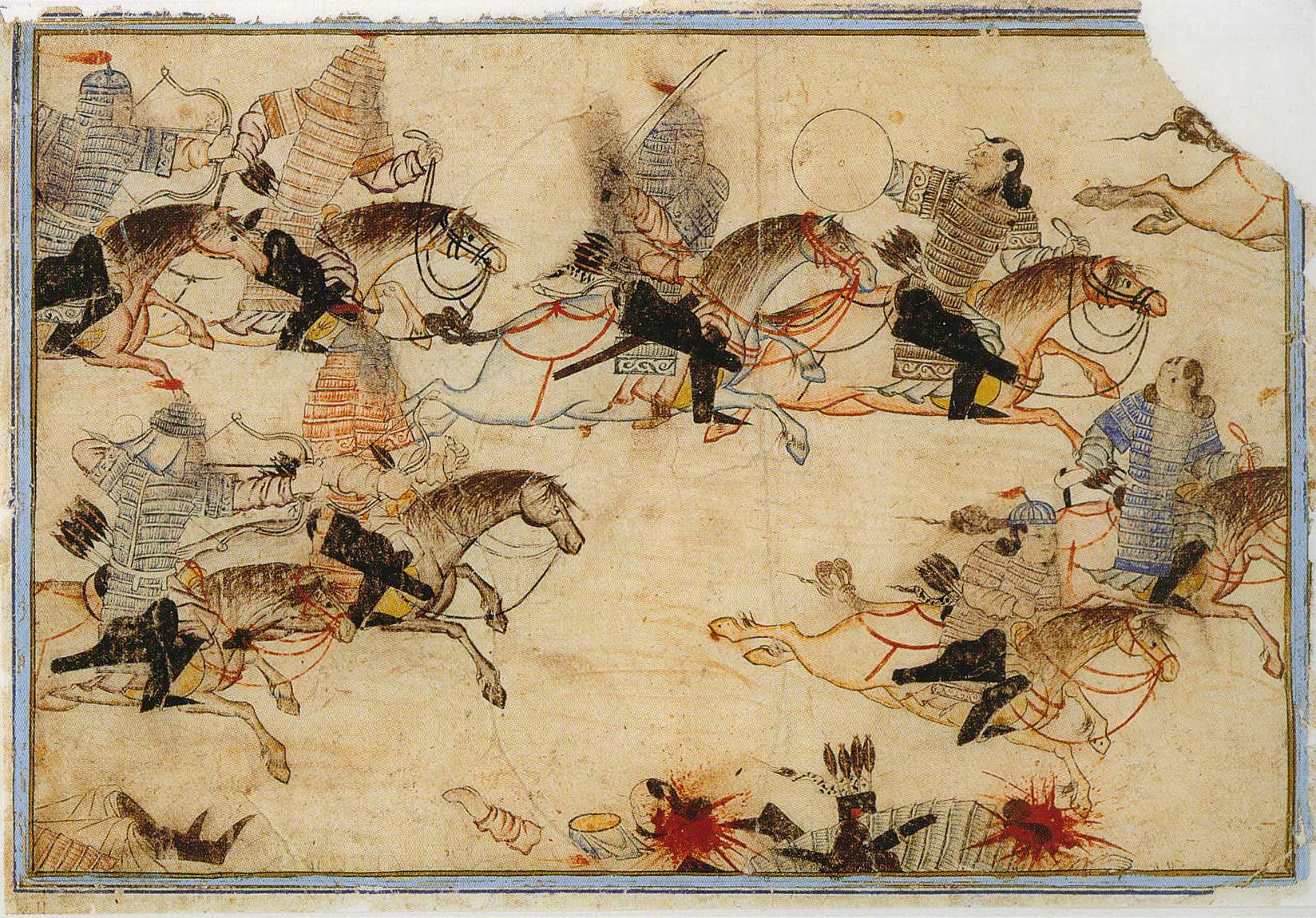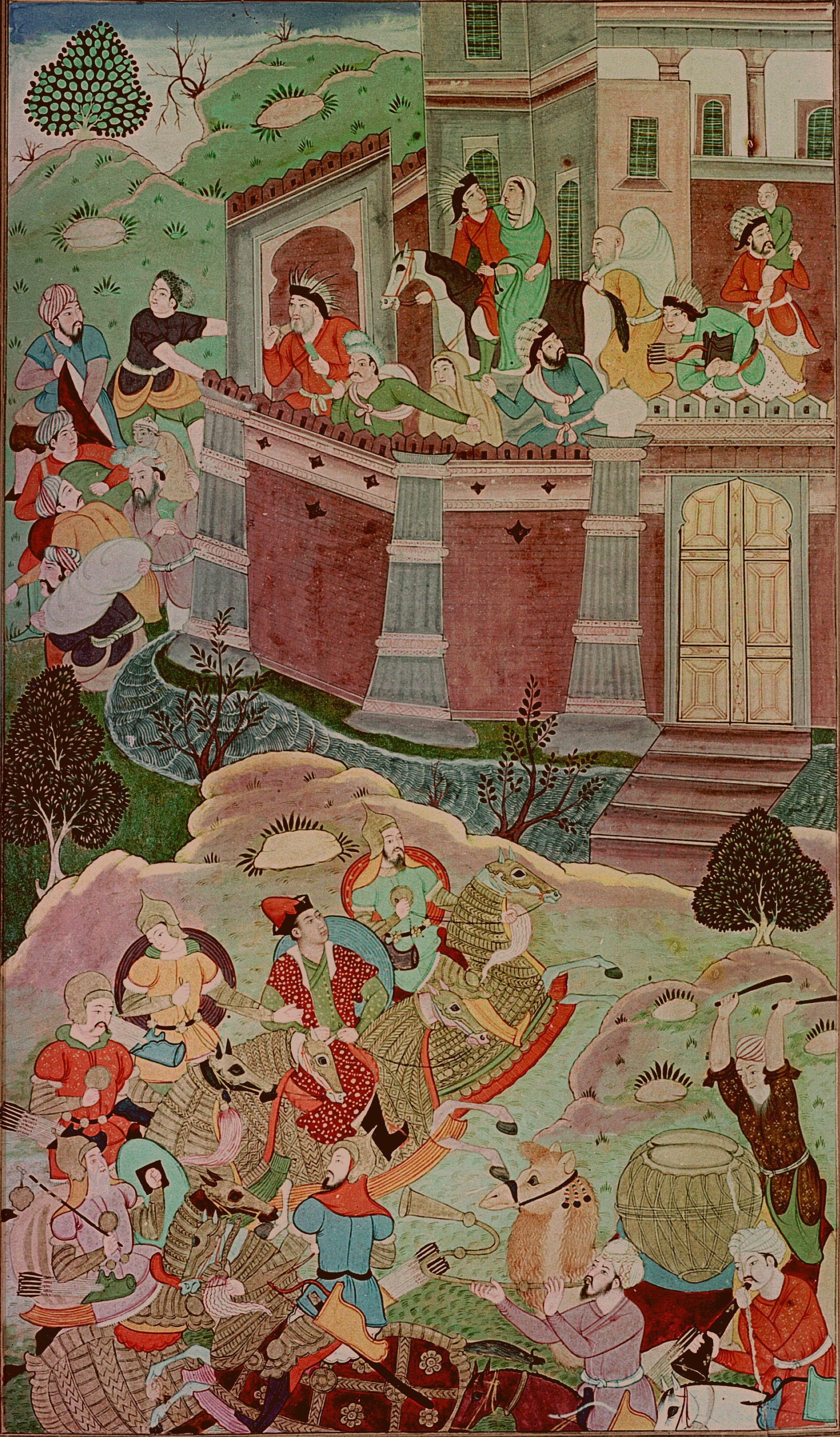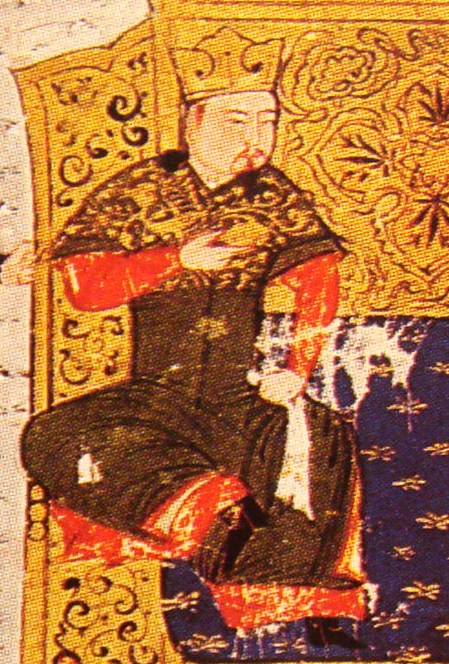|
Kublai
Kublai ; Mongolian script: ; (23 September 1215 – 18 February 1294), also known by his temple name as the Emperor Shizu of Yuan and his regnal name Setsen Khan, was the founder of the Yuan dynasty of China and the fifth khagan-emperor of the Mongol Empire from 1260 to 1294, although after the division of the empire this was a nominal position. He proclaimed the empire's dynastic name "Great Yuan" in 1271, and ruled Yuan China until his death in 1294. Kublai was the second son of Tolui by his chief wife Sorghaghtani Beki, and a grandson of Genghis Khan. He was almost 12 when Genghis Khan died in 1227. He had succeeded his older brother Möngke as Khagan in 1260, but had to defeat his younger brother Ariq Böke in the Toluid Civil War lasting until 1264. This episode marked the beginning of the fragmentation of the empire. Kublai's real power was limited to the Yuan Empire, even though as Khagan he still had influence in the Ilkhanate and, to a significantly lesser degree, ... [...More Info...] [...Related Items...] OR: [Wikipedia] [Google] [Baidu] |
Yuan Dynasty
The Yuan dynasty (), officially the Great Yuan (; xng, , , literally "Great Yuan State"), was a Mongol-led imperial dynasty of China and a successor state to the Mongol Empire after its division. It was established by Kublai, the fifth khagan-emperor of the Mongol Empire from the Borjigin clan, and lasted from 1271 to 1368. In orthodox Chinese historiography, the Yuan dynasty followed the Song dynasty and preceded the Ming dynasty. Although Genghis Khan had been enthroned with the Han-style title of Emperor in 1206 and the Mongol Empire had ruled territories including modern-day northern China for decades, it was not until 1271 that Kublai Khan officially proclaimed the dynasty in the traditional Han style, and the conquest was not complete until 1279 when the Southern Song dynasty was defeated in the Battle of Yamen. His realm was, by this point, isolated from the other Mongol-led khanates and controlled most of modern-day China and its surrounding areas, including ... [...More Info...] [...Related Items...] OR: [Wikipedia] [Google] [Baidu] |
Mongol Empire
The Mongol Empire of the 13th and 14th centuries was the largest contiguous land empire in history. Originating in present-day Mongolia in East Asia, the Mongol Empire at its height stretched from the Sea of Japan to parts of Eastern Europe, extending northward into parts of the Arctic; eastward and southward into parts of the Indian subcontinent, attempted invasions of Southeast Asia and conquered the Iranian Plateau; and westward as far as the Levant and the Carpathian Mountains. The Mongol Empire emerged from the unification of several nomadic tribes in the Mongol homeland under the leadership of Temüjin, known by the more famous title of Genghis Khan (–1227), whom a council proclaimed as the ruler of all Mongols in 1206. The empire grew rapidly under his rule and that of his descendants, who sent out invading armies in every direction. The vast transcontinental empire connected the East with the West, and the Pacific to the Mediterranean, in an enforced ''Pax Mongol ... [...More Info...] [...Related Items...] OR: [Wikipedia] [Google] [Baidu] |
Division Of The Mongol Empire
The division of the Mongol Empire began when Möngke Khan died in 1259 in the siege of Diaoyu Castle with no declared successor, precipitating infighting between members of the Tolui family line for the title of khagan that escalated into the Toluid Civil War. This civil war, along with the Berke–Hulagu war and the subsequent Kaidu–Kublai war, greatly weakened the authority of the great khan over the entirety of the Mongol Empire, and the empire fractured into four khanates: the Golden Horde in Eastern Europe, the Chagatai Khanate in Central Asia, the Ilkhanate in Southwest Asia, and the Yuan dynasty in East Asia based in modern-day Beijing – although the Yuan emperors held the nominal title of khagan of the empire. The four divisions each pursued their own interests and objectives and fell at different times. Dispute over succession Möngke Khan's brother Hulagu Khan broke off his successful military advance into Syria, withdrawing the bulk of his forces to Mughan and ... [...More Info...] [...Related Items...] OR: [Wikipedia] [Google] [Baidu] |
Ariq Böke
Ariq Böke (after 1219–1266), the components of his name also spelled Arigh, Arik and Bukha, Buka ( mn, Аригбөх, Arigböh, ; ), was the seventh and youngest son of Tolui and a grandson of Genghis Khan. After the death of his brother the Great Khan Möngke, Ariq Böke claimed the title of the Great Khan of the Mongol Empire and briefly took power while his brothers Kublai and Hulagu were absent from the Mongolian Plateau. When Kublai returned for an election in 1260, rival factions could not agree, and elected both claimants, Kublai and Ariq Böke, to the throne, resulting in the Toluid Civil War that fragmented the Mongol Empire. Ariq Böke was supported by the traditionalists of the Mongol Empire, while his brother Kublai was supported by the senior princes of North China and Manchuria. Early years Ariq Böke was the youngest son of Sorghaghtani Beki and Tolui, the youngest son of Genghis Khan. When Genghis died in 1227, the leadership of the Empire passed to Genghis' ... [...More Info...] [...Related Items...] OR: [Wikipedia] [Google] [Baidu] |
Araniko
Aniko, Anige or Araniko ( ne, अरनिको, zh, 阿尼哥; 1245–1306) was one of the key figures in the arts of Nepal and Yuan dynasty of China, and the artistic exchanges in these areas. He was born in Kathmandu Valley, Nepal, during the reign of Abhaya Malla. He is known for building the White Stupa at the Miaoying Temple in Beijing. During the reign of Jaya Bhim Dev Malla, he was sent on a project to build a golden stupa in Tibet, where he also initiated into monkhood. From Tibet he was sent further to North China to work in the court of the emperor Kublai Khan, the founder of Yuan dynasty (1279–1368), where he brought the trans-Himalayan artistic tradition to China. Araniko led a team of 80 artists to China and Tibet to make a number of pagoda style buildings. In his later life, he renounced monkhood and started a family. To some confusion in translation, his name is variously written as Arniko or Araniko in old texts. A mistake made by Baburam Acharya ascribed ... [...More Info...] [...Related Items...] OR: [Wikipedia] [Google] [Baidu] |
Temür Khan
Öljeytü Khan ( Mongolian: Өлзийт; Mongolian script: '; ), born Temür ( mn, Төмөр ; ; October 15, 1265 – February 10, 1307), also known as Emperor Chengzong of Yuan () by his temple name ''Chengzong'', was the second emperor of the Yuan dynasty of China, ruling from May 10, 1294 to February 10, 1307. Apart from Emperor of China, he is considered as the sixth Great Khan of the Mongol Empire, although it was only nominal due to the division of the empire. He was an able ruler of the Yuan dynasty, and his reign established the patterns of power for the next few decades. His name means "blessed iron Khan" in the Mongolian language. Temür was a son of the Crown Prince Zhenjin and a grandson of the Yuan founder Kublai Khan. During his rule, the western khanates of the Mongol Empire accepted the supremacy of the Yuan dynasty. Family *Empress Shiliandali, (失怜答里皇后) of the Hongjila clan (弘吉剌氏) from Onggirat, daughter of Oločin Küregen **Prince Desh ... [...More Info...] [...Related Items...] OR: [Wikipedia] [Google] [Baidu] |
Song Dynasty
The Song dynasty (; ; 960–1279) was an imperial dynasty of China that began in 960 and lasted until 1279. The dynasty was founded by Emperor Taizu of Song following his usurpation of the throne of the Later Zhou. The Song conquered the rest of the Ten Kingdoms, ending the Five Dynasties and Ten Kingdoms period. The Song often came into conflict with the contemporaneous Liao, Western Xia and Jin dynasties in northern China. After retreating to southern China, the Song was eventually conquered by the Mongol-led Yuan dynasty. The dynasty is divided into two periods: Northern Song and Southern Song. During the Northern Song (; 960–1127), the capital was in the northern city of Bianjing (now Kaifeng) and the dynasty controlled most of what is now Eastern China. The Southern Song (; 1127–1279) refers to the period after the Song lost control of its northern half to the Jurchen-led Jin dynasty in the Jin–Song Wars. At that time, the Song court retreated south of the ... [...More Info...] [...Related Items...] OR: [Wikipedia] [Google] [Baidu] |
Temple Name
Temple names are posthumous titles accorded to monarchs of the Sinosphere for the purpose of ancestor worship. The practice of honoring monarchs with temple names began during the Shang dynasty in China and had since been adopted by other dynastic regimes in the Sinosphere, with the notable exception of Japan. Temple names should not be confused with era names (年號), regnal names (尊號) or posthumous names (謚號). Modern academia usually refers to the following rulers by their temple names: Chinese monarchs from the Tang to the Yuan dynasties, Korean rulers of the Goryeo (until AD 1274) and Joseon dynasties, and Vietnamese rulers of the Lý, Trần, and Later Lê dynasties (with the Hồ and Later Trần dynasties as exceptions). Numerous individuals who did not rule as monarch during their lifetime were posthumously elevated to the position of monarch by their descendants and honored with temple names. For example, Cao Cao was posthumously honored as an emperor ... [...More Info...] [...Related Items...] OR: [Wikipedia] [Google] [Baidu] |
Tolui
Tolui (also Toluy, Tului; , meaning: "the mirror"; – 1232) was a Mongol khan, the fourth son of Genghis Khan by his chief khatun, Börte. At his father's death in 1227, his ''Orda (organization), ulus'', or territorial inheritance, was the Mongol homelands on the Mongolian Plateau, and he also served as civil administrator until 1229, the time it took to confirm Ögedei Khan, Ögedei as the second Khagan, Great Khan of the Mongol Empire (1206–1368). Before that, he had served with distinction in the campaigns against the Jin dynasty (1115–1234), Jin dynasty, the Mongol conquest of Western Xia, Western Xia and the Khwarezmid Empire, where he was instrumental in the capture and massacre at Merv and Nishapur. He is a direct ancestor of most of the Ilkhanids. Tolui never used the title of Khagan himself; neither Genghis Khan nor his immediate three successors would ever use any Chinese era name, era names unlike the neighboring Zhongyuan, Central Plain dynasties in the south ... [...More Info...] [...Related Items...] OR: [Wikipedia] [Google] [Baidu] |
List Of Yuan Emperors
The following is a list of emperors of the Yuan dynasty (1271–1368). It also contains early rulers (khagans-emperors and regents) of the Mongol Empire posthumously honored by Kublai Khan as Yuan emperors. List of emperors Timeline ImageSize = width:1600 height:auto barincrement:15 PlotArea = top:10 bottom:30 right:120 left:20 AlignBars = early DateFormat = yyyy Period = from:1200 till:1390 TimeAxis = orientation:horizontal ScaleMajor = unit:year increment:10 start:1200 Colors = id:canvas value:rgb(0.97,0.97,0.97) id:ME value:rgb(1,0.6,0.2) id:YU value:rgb(0.2,0.8,0.8) id:NY value:rgb(1,0.2,0.6) Backgroundcolors = canvas:canvas BarData = barset:Rulers PlotData= width:5 align:left fontsize:S shift:(5,-4) anchor:till barset:Rulers from: 1206 till: 1227 color:ME text:"Genghis Khan (1206–1227 CE)" from: 1227 till: 1229 color:ME text:"Tolui (regent; 1227–1229 CE)" from: 1229 till: 1241 color:ME text:"Ögedei Khan (1 ... [...More Info...] [...Related Items...] OR: [Wikipedia] [Google] [Baidu] |
List Of Emperors Of The Yuan Dynasty
The following is a list of emperors of the Yuan dynasty (1271–1368). It also contains early rulers ( khagans-emperors and regents) of the Mongol Empire posthumously honored by Kublai Khan as Yuan emperors. List of emperors Timeline ImageSize = width:1600 height:auto barincrement:15 PlotArea = top:10 bottom:30 right:120 left:20 AlignBars = early DateFormat = yyyy Period = from:1200 till:1390 TimeAxis = orientation:horizontal ScaleMajor = unit:year increment:10 start:1200 Colors = id:canvas value:rgb(0.97,0.97,0.97) id:ME value:rgb(1,0.6,0.2) id:YU value:rgb(0.2,0.8,0.8) id:NY value:rgb(1,0.2,0.6) Backgroundcolors = canvas:canvas BarData = barset:Rulers PlotData= width:5 align:left fontsize:S shift:(5,-4) anchor:till barset:Rulers from: 1206 till: 1227 color:ME text:" Genghis Khan (1206–1227 CE)" from: 1227 till: 1229 color:ME text:"Tolui (regent; 1227–1229 CE)" from: 1229 till: 1241 color:ME text:"Ögedei Kha ... [...More Info...] [...Related Items...] OR: [Wikipedia] [Google] [Baidu] |
Emperor Of The Yuan Dynasty
The following is a list of emperors of the Yuan dynasty (1271–1368). It also contains early rulers ( khagans-emperors and regents) of the Mongol Empire posthumously honored by Kublai Khan as Yuan emperors. List of emperors Timeline ImageSize = width:1600 height:auto barincrement:15 PlotArea = top:10 bottom:30 right:120 left:20 AlignBars = early DateFormat = yyyy Period = from:1200 till:1390 TimeAxis = orientation:horizontal ScaleMajor = unit:year increment:10 start:1200 Colors = id:canvas value:rgb(0.97,0.97,0.97) id:ME value:rgb(1,0.6,0.2) id:YU value:rgb(0.2,0.8,0.8) id:NY value:rgb(1,0.2,0.6) Backgroundcolors = canvas:canvas BarData = barset:Rulers PlotData= width:5 align:left fontsize:S shift:(5,-4) anchor:till barset:Rulers from: 1206 till: 1227 color:ME text:" Genghis Khan (1206–1227 CE)" from: 1227 till: 1229 color:ME text:"Tolui (regent; 1227–1229 CE)" from: 1229 till: 1241 color:ME text:"Ögedei Kha ... [...More Info...] [...Related Items...] OR: [Wikipedia] [Google] [Baidu] |







